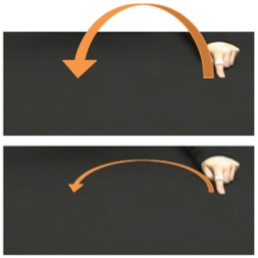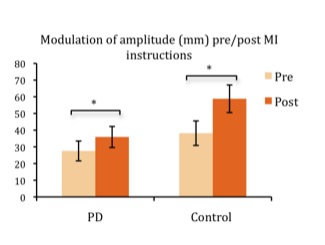Session Information
Date: Wednesday, June 7, 2017
Session Title: Parkinson's Disease: Cognition
Session Time: 1:15pm-2:45pm
Location: Exhibit Hall C
Objective: This study investigated the effects of action observation and motor imagery on movement amplitude in people with Parkinson’s disease.
Background: Action observation (AO) influences movement and learning via activation of neural structures involved in action execution. Although some positive effects of AO and imitation have been reported in PD, findings are inconsistent. Combining AO with motor imagery (MI) increases behavioural and neural effects in healthy individuals[1] but this has not been explored in PD.
Methods: Participants with mild to moderate PD (n = 24) and healthy older adults (n = 24) observed and imitated videos showing a human hand moving in either an elevated or a non-elevated path between target positions (Fig. 1). Movement kinematics were recorded and imitation was measured in terms of modulation of amplitude for elevated vs. non-elevated videos. After an initial set of imitation trials (AO), further instructions were given to promote the use of MI, emphasizing kinaesthetic elements of imagery (imagined sensations). A second set of trials was then completed (AO+MI). Participants reported their use of MI in each part of the task.
[Figure 1. Video stimuli depicted elevated or non-elevated hand movements.]
Results: Both groups modulated the amplitude of their hand movements in response to elevated vs. non-elevated videos (p < .001), and this was greater following MI instructions (time * elevation; p = .005), demonstrating increased imitation (Fig. 2). However, modulation was larger overall in the control group, and correlated positively with kinaesthetic MI ratings in controls but not in the PD group. This suggests that people with PD may engage different mechanisms during MI, consistent with previous research indicating an increased reliance on visual processes[2].
[Figure 2. Modulation of hand movement amplitude (+/-1SEM) before and after MI instructions. *p < .05]
Conclusions: People with PD are able to imitate the amplitude of simple hand movements, and imitation is increased when action observation is combined with motor imagery. Our results parallel findings from healthy young participants and indicate that combined AO+MI is a promising approach to motor facilitation in PD. Further research is needed to elucidate mechanisms of AO and MI in PD and to explore therapeutic effects.
References: Eaves D, Riach M, Holmes PS, & Wright DJ. Motor imagery during action observation: A brief review of evidence, theory and future research opportunities. Frontiers in Neuroscience 2016; 10: 514.
van Nuenen BFL, Helmich RC, Buenen N et al. Compensatory activity in the extrastriate body area of Parkinson’s disease patients. Journal of Neuroscience 2012; 32(28): 9546-9553.
To cite this abstract in AMA style:
J. Bek, E. Gowen, S. Vogt, T. Crawford, E. Poliakoff. Motor imagery increases imitation of hand movements in Parkinson’s disease [abstract]. Mov Disord. 2017; 32 (suppl 2). https://www.mdsabstracts.org/abstract/motor-imagery-increases-imitation-of-hand-movements-in-parkinsons-disease/. Accessed April 2, 2025.« Back to 2017 International Congress
MDS Abstracts - https://www.mdsabstracts.org/abstract/motor-imagery-increases-imitation-of-hand-movements-in-parkinsons-disease/


